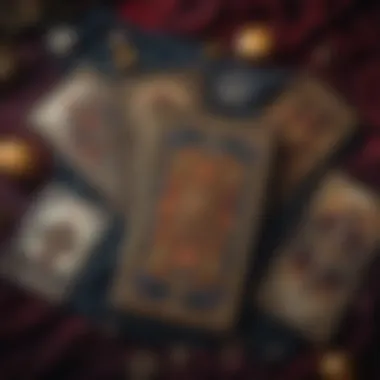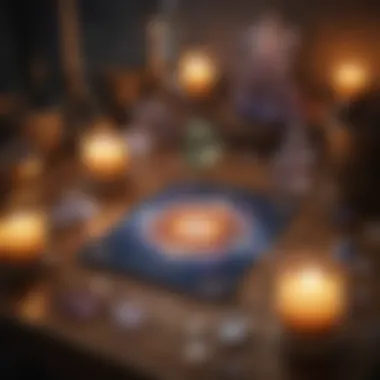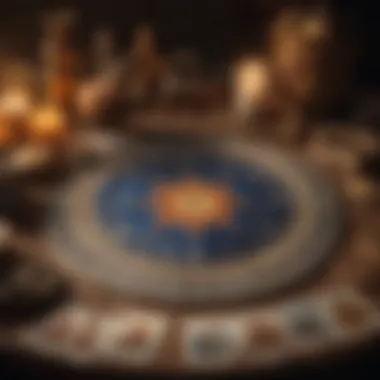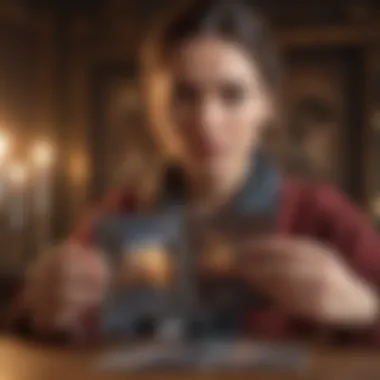Exploring the Diverse Techniques of Card Readings


Intro
In the vast universe of card readings, each method provides distinct insights into the human experience. This article serves as a comprehensive guide, delineating various techniques and their meanings. Whether one approaches card readings from an astrological perspective or seeks personal wisdom, understanding the rooted concepts enriches the practice. This guide aims to shed light on popular card reading methods while offering practical applications valuable for enthusiasts and practitioners alike.
Understanding the Zodiac
Overview of Zodiac Signs
The Zodiac consists of twelve distinct signs, each associated with specific dates in the calendar year. These signs serve as more than just mere labels; they embody individual characteristics and traits that can guide one's understanding of personal habits and relationships.
Sign Traits and Characteristics
Each Zodiac sign possesses unique traits:
- Aries: Bold and ambitious, often initiates new beginnings.
- Taurus: Grounded and reliable, values comfort and stability.
- Gemini: Adaptable and communicative, thrives on change.
- Cancer: Nurturing and empathetic, values home and family.
- Leo: Charismatic and confident, seeks to be in the spotlight.
- Virgo: Detail-oriented and analytical, often looks for perfection.
- Libra: Diplomatic and fair-minded, values harmony and balance.
- Scorpio: Passionate and intense, is drawn to the deeper aspects of life.
- Sagittarius: Independent and adventurous, seeks knowledge and freedom.
- Capricorn: Disciplined and ambitious, values hard work and success.
- Aquarius: Innovative and humanitarian, often challenges the norm.
- Pisces: Intuitive and artistic, is deeply connected to emotions.
Elemental Qualities
Zodiac signs are also associated with four elemental qualities:
- Fire: Aries, Leo, Sagittarius - associated with enthusiasm and spontaneity.
- Earth: Taurus, Virgo, Capricorn - linked to practicality and grounded nature.
- Air: Gemini, Libra, Aquarius - connected to intellect and communication.
- Water: Cancer, Scorpio, Pisces - associated with emotion and intuition.
These elemental categories not only enhance the personality traits of each sign but also provide insights into compatibility and individual experiences.
Each Zodiac sign serves as a mirror, reflecting aspects of human nature while guiding one’s path in life.
Astrological Insights
Current Astrological Trends
Astrology is a living practice; it evolves with the cosmos. Observing current planetary movements can shed light on collective experiences. For instance, a retrograde period often signifies a time for introspection and reassessment.
Influence of Celestial Events
Celestial events, such as eclipses or alignments, can influence human behavior and decision-making. Understanding these impacts helps deepen one's astrological insights. Practitioners often suggest using this knowledge for personal growth and navigating challenges.
How to Interpret Your Birth Chart
A birth chart is a snapshot of celestial positions at the moment of one's birth. It provides insights into personality, potential life paths, and relationships. Learning to read a birth chart requires studying:
- Planetary placements: Indicates qualities and experiences.
- Houses: Each house represents different aspects of life.
- Aspects: The angles between planets reveal dynamics within an individual’s personality.
Horoscope and Predictions
Monthly or Weekly Forecasts
Horoscopes offer a glimpse into future influences based on current astrological positions. Regular updates help individuals plan their activities and approach challenges with awareness.
Personalized Horoscope Reading
A personalized horoscope provides a deeper dive into one’s unique astrological makeup. Combining personal charts with current transits allows for tailored insights.
Compatibility Readings based on Zodiac signs
Compatibility readings analyze the interaction between different Zodiac signs. This approach considers both emotional and elemental aspects, helping individuals understand relationship dynamics better.
By gaining insight into the intricate world of card readings and astrological principles, one develops a deeper comprehension of self and others. This journey is not just about predictions but embracing the factors that shape our realities.
Intro to Card Readings
Card readings have gained attention as a powerful tool for self-exploration and insight. Understanding how to read cards is essential, as it unravels a layered landscape of interpretation, intuition, and tradition. This section introduces the fundamental concepts and historical background of card readings, setting the stage for deeper exploration in later sections.


What Are Card Readings?
Card readings involve the practice of drawing cards from a specific deck and interpreting them to gain insights into one’s life or situation. Each card, whether part of a Tarot, Oracle, or Lenormand deck, carries unique meanings. The act of interpretation can vary significantly based on the methodology used by the reader. Over time, card readings have transitioned from a purely divinatory practice to a method for personal reflection.
Practitioners aim to unveil messages that may resonate with personal experiences or future possibilities. This process is both an art and a science, intertwining intuition with conventional interpretations. For many, card readings serve as a catalyst for self-discovery, offering a different vantage point on challenges or decisions in their lives.
Historical Context of Card Readings
The origins of card reading can be traced back several centuries. The earliest known decks appeared in the 15th century in Europe. Initially, they were not associated with divination but were used for playing games. By the late 18th century, Tarot decks began to emerge as tools for fortune-telling and spiritual guidance. The transformation reflected changing cultural views on fate, destiny, and intuition.
In Europe, Tarot cards spread across countries, each region adopting its interpretations and techniques. Meanwhile, other cultures developed their own card systems, like the Lenormand in France. The enduring popularity of these practices illustrates a universal desire to seek clarity in a complex world.
Importantly, as card reading practices evolved, various psychological and philosophical schools began to integrate these techniques into their understanding of human behavior. This blending further enriched the practice, as card readings became more than just a method of fortune-telling; they transformed into tools for introspection and personal development.
In the spirit of exploration, card readings beckon individuals to understand their subconscious and express their inner narratives.
Types of Card Decks
Understanding the types of card decks is essential for anyone delving into card readings. Different decks have unique designs, imagery, and meanings, which can significantly influence the reader's interpretations. Choosing the right deck tailored to one's needs can enhance intuition and provide clearer insights. Each deck carries a distinct tradition and approach, which can shape the reading experience in powerful ways.
Tarot Cards
Tarot cards are perhaps the most well-known type of card deck used in readings. A typical tarot deck comprises 78 cards, divided into the Major Arcana and Minor Arcana. The Major Arcana consists of 22 cards that depict significant life events, spiritual lessons, or archetypes. On the other hand, the Minor Arcana has 56 cards divided into four suits that represent daily experiences, challenges, and smaller events.
When using tarot cards, readers often employ a range of spreads, each designed to explore different aspects of a query. The cards' imagery and symbolism offer a rich tapestry for interpretation. Tarot readings can facilitate deep self-reflection and insight into personal issues or situations.
Benefits
- Offers deep insights into complex issues.
- Encourages self-exploration and growth.
- Versatile in application, useful for various queries.
Oracle Cards
Oracle cards differ notably from tarot decks. They typically lack a standard structure and can vary significantly in the number of cards, themes, and artwork. Oracle decks may center on specific themes such as angelic guidance, affirmations, or even nature. This flexibility allows for a broader interpretation and can cater to diverse audiences and topics.
Readers often find oracle cards more intuitive, as the messages can be seen as direct guidance rather than traditional interpretations. This can be beneficial for practitioners who prefer a more individualized approach to readings.
Considerations
- Less structured than tarot, allowing for personal interpretation.
- Great for quick guidance and inspiration.
- Themes and messages vary widely.
Lenormand Cards
Lenormand cards present another fascinating classification within card reading. This system uses a smaller deck, typically consisting of 36 cards, and offers a unique visual and symbolic language. Unlike tarot or oracle cards, the Lenormand readings often focus on practical aspects and events.
Each card in the Lenormand system carries specific meanings that combine with other cards for interpretation, resulting in a multilayered message. This method emphasizes clarity in forecasting and provides pragmatic insights into questions. Many practitioners appreciate the straightforwardness that Lenormand readings can deliver.
Highlights
- Shorter deck, leading to quicker readings.
- Focuses on concrete and practical guidance.
- Highly contextual, requiring card combinations for interpretation.
In summary, the types of card decks serve as a gateway into the diverse landscape of card reading. Understanding the specific characteristics and advantages of each deck can empower readers to select one that aligns with their intentions and inquiry goals.
Traditional Card Reading Techniques
Traditional card reading techniques hold a crucial place in the realm of divination. They serve not only as methods to gain insights but also as pathways for self-discovery and understanding personal challenges. This section discusses several well-known card spreads, each with a distinctive focus and approach, allowing practitioners to tailor their readings based on specific needs.
Three-Card Spread
The Three-Card Spread is one of the simplest yet most effective card reading techniques. It offers a snapshot view of a situation. Each card represents a different aspect: the past, present, and future. This layout is beneficial for those seeking quick insights without delving deeply into complex interpretations.
- Past Card: This card sheds light on previous influences affecting the current situation. Notable events, choices, or emotions may surface, helping the seeker understand their trajectory.
- Present Card: This reflects the current emotional or situational state. It reveals immediate challenges or opportunities that the seeker faces.
- Future Card: The closing card provides a glimpse into potential outcomes or paths. This card does not dictate fate, but it offers guidance on likely developments based on current choices.


Using this spread is advantageous for its simplicity and speed. Readers can use it for everyday inquiries or significant life events. It encourages reflection and active engagement with one’s circumstances.
Celtic Cross Spread
The Celtic Cross Spread represents a classic approach to card readings, often favored for its depth and comprehensive nature. It involves ten cards, each serving a unique role in the reading. This method provides valuable insights across multiple dimensions of life.
Key positions include:
- The Significator: The central card representing the querent's current situation.
- The Crossing Card: This card indicates immediate obstacles or challenges facing the seeker.
- Foundation Card: Offering context, this position reveals underlying influences.
- Past Influences: Cards in this spot show what has led to the present moment.
The Celtic Cross facilitates an in-depth exploration of one's life, prompting introspection and guided understanding. It is ideal for more profound queries, as it offers a multifaceted view of circumstances.
Past-Present-Future Spread
The Past-Present-Future Spread closely resembles the Three-Card Spread but allows for more nuanced interpretation, as it can involve more than three cards to provide additional layers of understanding. Practitioners can draw two to three cards each for past, present, and future aspects, depending on their inquiry.
- Past: Multiple cards can illustrate significant events and decisions impacting the querent's journey.
- Present: Here, the focus might include current thoughts and emotions that shape actions.
- Future: Similar to the past, this aspect may reveal several potential paths. This variability encourages the seeker to weigh different options.
While it adds complexity, this spread enhances potential insights for those prepared for a more layered reading experience. It promotes ongoing dialogue between the reader and seeker about past experiences and future aspirations.
Modern Card Reading Approaches
The field of card readings has evolved significantly over time, embracing a variety of contemporary techniques that reflect the diverse needs and inclinations of users today. Modern card reading approaches emphasize flexibility, creativity, and personal interpretation. This section will delve into three noteworthy methods: intuitive card reading, psychic card reading, and digital card reading. Each method offers distinct benefits and considerations, catering to both seasoned practitioners and newcomers alike.
Intuitive Card Reading
Intuitive card reading focuses on the reader's instinctive feelings and personal insights rather than strict guidelines or established meanings. This approach allows individuals to tap into their emotional and mental landscape to draw interpretations from the cards that resonate with their personal experiences.
Benefits of intuitive card reading include:
- Personal Connection: Each reading reflects the reader's unique perspective, making the insights more relatable.
- Flexibility: Readers can adapt their interpretations based on immediate context, responsiveness, and evolving situations.
- Creativity: This method fosters creative expression, allowing readers to explore meanings that transcend traditional definitions.
Considerations for this method involve emphasizing self-awareness and practice. Readers should develop their intuitive skills gradually, cultivating a trusting relationship with their instincts. As this practice matures, readers often find their confidence increasing when offering insights to others.
Psychic Card Reading
Psychic card reading combines traditional card reading with psychic abilities. Practitioners who identify as psychics may use their extrasensory skills to enhance the reading process, providing deeper layers of interpretation.
Key aspects of psychic card reading include:
- Enhanced Insight: Readers may receive information beyond the traditional card meanings, offering a more profound understanding of the situation.
- Holistic Perspective: This approach aligns the reader's psychic abilities with the cards, creating a comprehensive view of the querent's circumstances.
- Energy Awareness: Practitioners often emphasize the importance of being attuned to the querent's energy, which can influence the reading's outcome.
Despite these advantages, those interested in psychic card reading should approach it with caution. Strong psychic abilities may not be necessary for everyone, and recognizing inherent limitations will help prevent misunderstandings and misinterpretations during readings.
Digital Card Reading
The rise of technology has led to the emergence of digital card reading, a modern twist on traditional practices. This technique encompasses online platforms, mobile applications, and virtual courses, making card reading accessible to a wider audience.
Some points to consider regarding digital card reading include:
- Accessibility: No matter where one is located, people can engage in card readings from the comfort of their homes.
- Variety of Resources: Many digital platforms offer numerous card decks and reading styles, allowing users to experiment without commitment.
- Community Building: Online forums and social media groups provide spaces for like-minded individuals to exchange insights, share experiences, and foster a sense of belonging.
While the convenience of digital card reading is undeniable, it is crucial to remain discerning about which platforms to engage with. Quality content and ethical practices should always guide users through their digital journeys.
In summary, modern card reading approaches reflect the dynamic landscape of spirituality and mindfulness today. By embracing intuitive, psychic, and digital methods, practitioners can tailor their readings to meet individual needs and preferences.
Cultural Variations in Card Readings
Card readings are not only a personal journey but also a cultural expression. Different regions and cultures have distinct interpretations and practices surrounding card readings. This section examines how cultural variations contribute to the landscape of card readings, enrich the practice, and offer diverse insights. Understanding these variations is essential for any practitioner or enthusiast in delving deeper into the complexities of card readings.
Eastern Influence on Card Readings


Eastern traditions have significantly shaped how card readings are approached. For instance, in countries like China and India, card reading intertwines with ancient philosophies and spiritual beliefs. The use of cards, such as tarot or oracle, reflects a fusion of astrology, numerology, and intuitive interpretations.
In many Eastern contexts, card readings often emphasize collective wisdom and community insights rather than individualism. The focus tends to be more holistic, concerning not only the individual’s fate but also the communal harmony and cosmic balance.
Incorporating elements from practices like Buddhism or Taoism can add another layer of depth. For instance, the concept of impermanence in Buddhism invites practitioners to acknowledge change and find insight in their readings, encouraging a mindset of acceptance.
Western Card Reading Traditions
Western cultures have developed their own unique card reading traditions. The tarot, widely recognized in Western contexts, is a prime example. The tarot deck is comprised of the Major and Minor Arcana, each card bearing specific symbolic meanings. The structure has allowed for various methods of interpretation, from psychological insights to predictive readings.
Moreover, Western traditions often emphasize individual agency and personal empowerment. Card readings are seen as tools for self-discovery and a means for the querent to take charge of their lives.
In contrast to Eastern approaches, Western readings might lean more towards personal success and goal-setting, reflecting societal values. Techniques such as visualization and affirmations often accompany the readings, providing a modern twist to traditional practices.
A deep understanding of both Eastern and Western card reading traditions can enhance one’s practice, offering broader perspectives and richer insights.
Recognizing these cultural variances can elevate the practice of card reading. For practitioners, being aware of diverse influences can enhance their techniques and ultimately enrich the readings for their clients.
Card Reading for Personal Development
Card readings serve as powerful tools for personal development. They offer insights that often lead to self-discovery and empowerment. Understanding oneself is a journey that can be enhanced significantly through such practices. Card readings can assist individuals in identifying patterns, confronting challenges, and envisioning future paths. This section delves into the importance of card readings in personal development, outlining specific elements and benefits.
Using Card Readings for Self-Reflection
Self-reflection is crucial in personal growth. Card readings act as mirrors, reflecting one's inner world. Through this process, individuals can better understand their thoughts, emotions, and motivations.
When engaging in self-reflection through card readings, a few important aspects emerge:
- Clarity: The imagery and meanings of the cards bring clarity to complex feelings or situations.
- Awareness: It encourages awareness of internal patterns that may influence behavior.
- Introspection: It fosters introspection, prompting questions that lead to deeper understanding.
The practice can be both enlightening and transformative. Setting aside regular time for readings can create an invaluable routine for personal exploration. Participants often report feeling more aligned with their true selves after such sessions.
Relationship Insights through Card Readings
Relationships are central to our personal experience, making their examination vital for development. Card readings can illuminate the dynamics in personal relationships—be it romantic, familial, or friendships.
Some noteworthy benefits of utilizing card readings for relationship insights include:
- Communication Improvement: Understanding one's feelings helps improve communication with others.
- Conflict Resolution: Insights can reveal underlying issues that cause conflicts, allowing for more effective resolutions.
- Connection Deepening: Card readings sharpen empathy by highlighting the emotions and perspectives of others.
By analyzing interactions and behaviors through the lens of card readings, individuals can gain a deeper understanding of their relationships. This awareness can lead to healthier, more fulfilling connections.
Card readings facilitate a unique exploration of the self and one's interactions with others, paving the way for profound personal growth and understanding.
Common Misconceptions about Card Readings
Common misconceptions surrounding card readings often cloud their value and effectiveness. Disentangling myths from facts allows for a clearer appreciation of how card readings can enrich personal understanding and decision-making. Addressing these misconceptions serves to demystify the practice and invites more individuals to explore its potential applications.
Myths and Facts
Many myths exist regarding card readings. Some believe card readings predict the future with absolute certainty, while others think they are merely a form of entertainment. Neither of these views captures the essence of card readings.
- Myth: Card readings provide definitive predictions of the future.
Fact: Card readings offer insights based on current circumstances. They suggest possible outcomes but do not guarantee them. The future remains fluid, influenced by choices and circumstances. - Myth: Card readings are only for the superstitious or the uneducated.
Fact: Individuals from diverse backgrounds engage in card readings for various reasons, including self-reflection and personal growth. Many practitioners are well-informed and use card readings as one of many tools in their exploration of life. - Myth: It requires special powers to read cards effectively.
Fact: Anyone can learn the techniques of card reading. Skill develops through practice and understanding of the cards, rather than exclusive innate ability.
Understanding these truths helps demystify card readings. It creates a foundation for appreciation of the practice. The significance of insights obtained during a reading often outweighs any misconceptions.
End
In this exploration of card readings, it becomes clear that the topic is rich with diversity and depth. Understanding card readings goes beyond mere fortune-telling; it encompasses an array of techniques and cultural significances that can greatly benefit individuals seeking clarity and insight.
Final Thoughts on Card Readings
As we conclude, it is vital to appreciate the multifaceted nature of card readings. Each technique, whether traditional or modern, serves a purpose that can assist in personal growth and self-discovery. Moreover, cultural variations provide additional layers of understanding that enrich the practice. Exploring card readings allows for an introspective journey, facilitating deeper connections with oneself and one's surroundings.
"Every card tells a story, but it is the seeker who interprets the narrative."
In summary, delving into card readings offers not only spiritual insights, but also a practical tool for navigating life's complexities. It invites people to engage with their own intuition, develop critical thinking skills, and enhance their decision-making processes. For astrologers, tarologists, and esotericists, card readings can become a vital instrument in understanding the intricate weave of life’s patterns. Thus, embracing this rich landscape is essential for anyone interested in the profound wisdom it holds.







